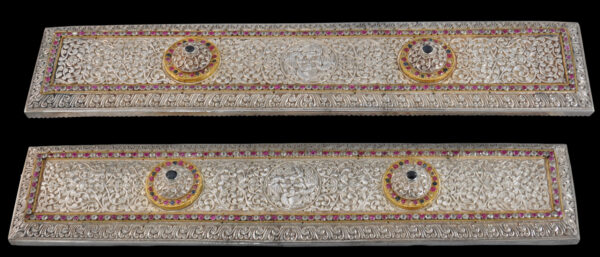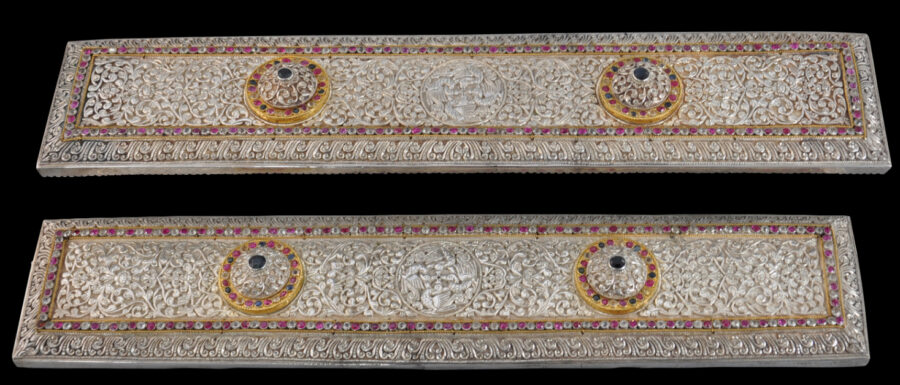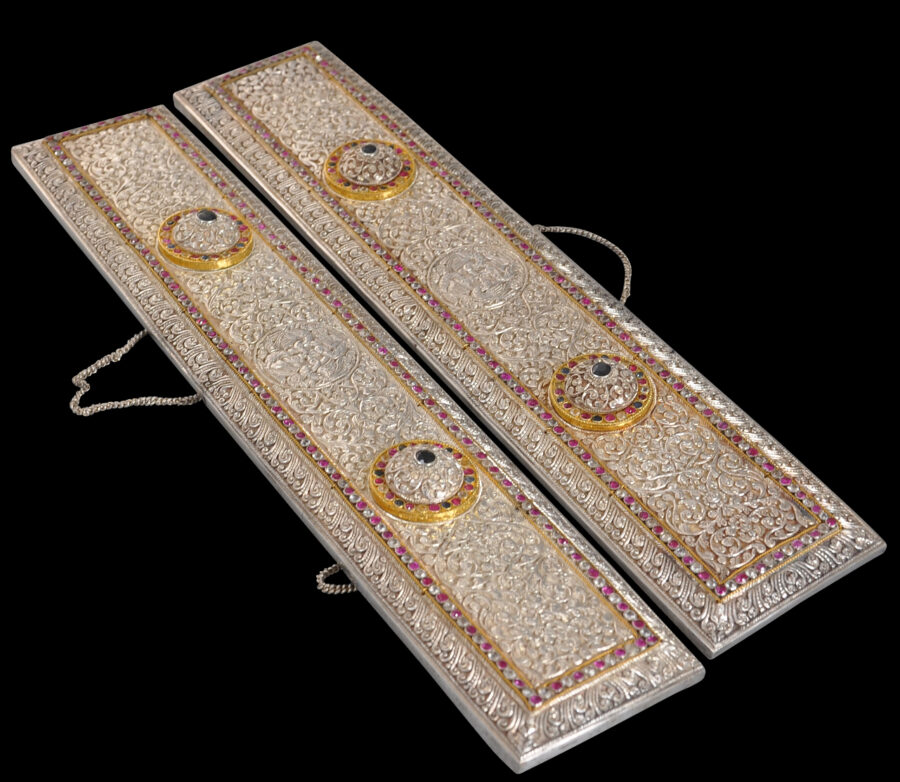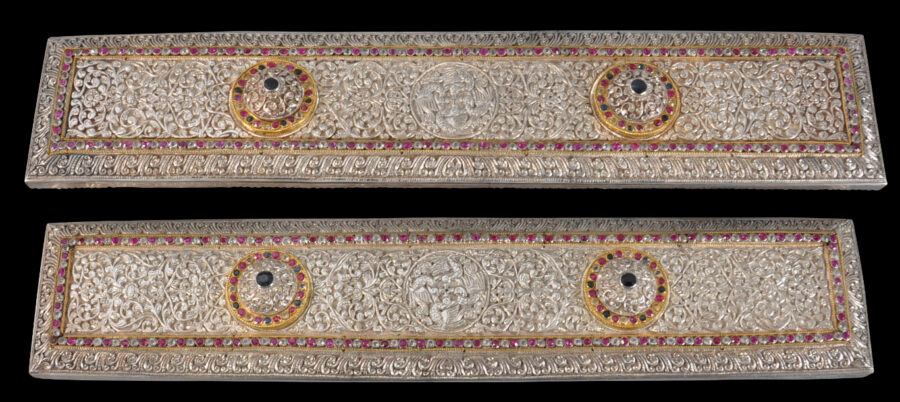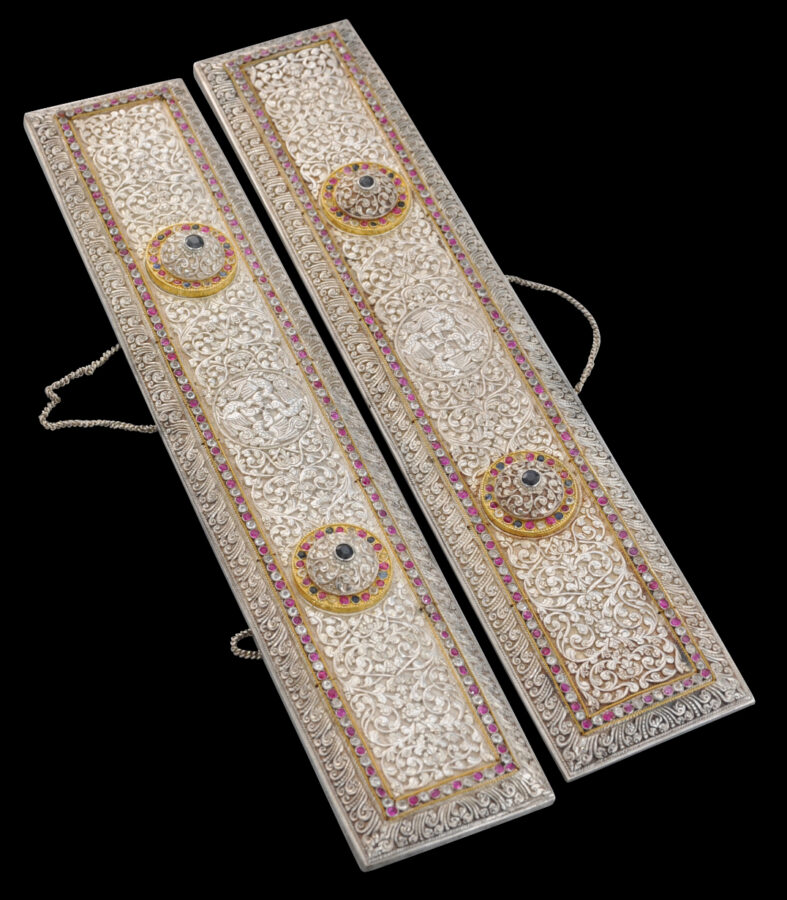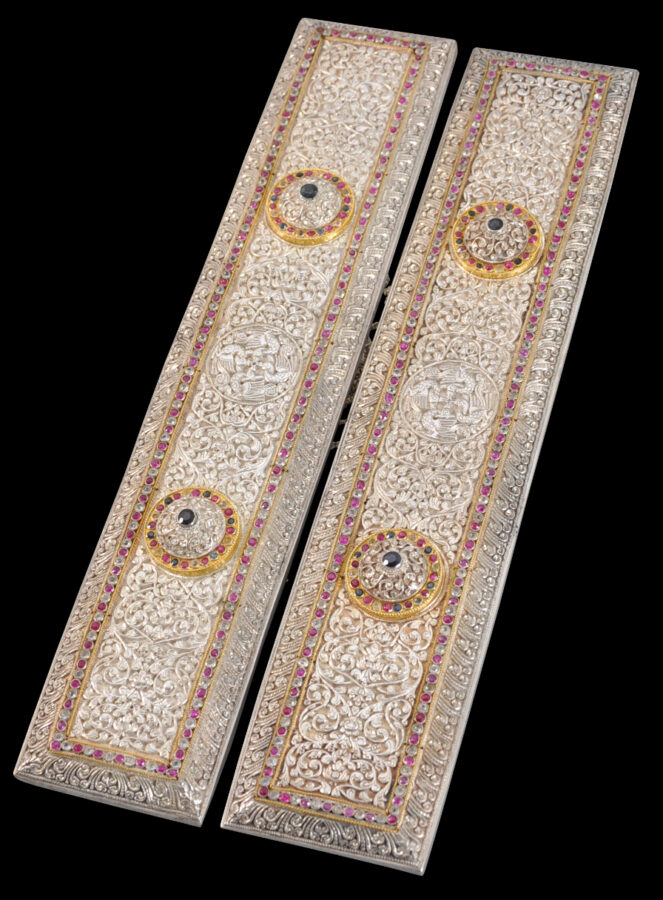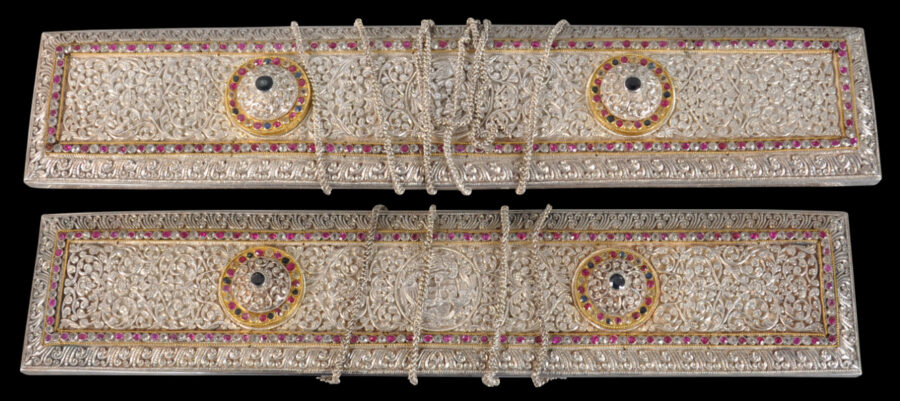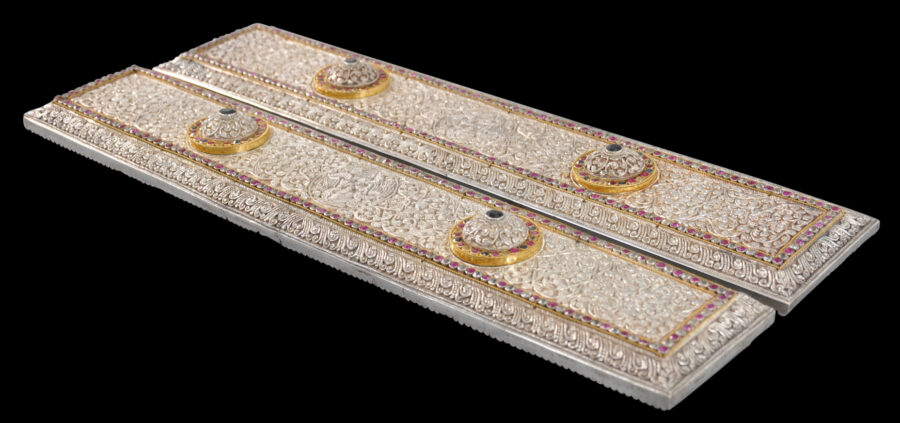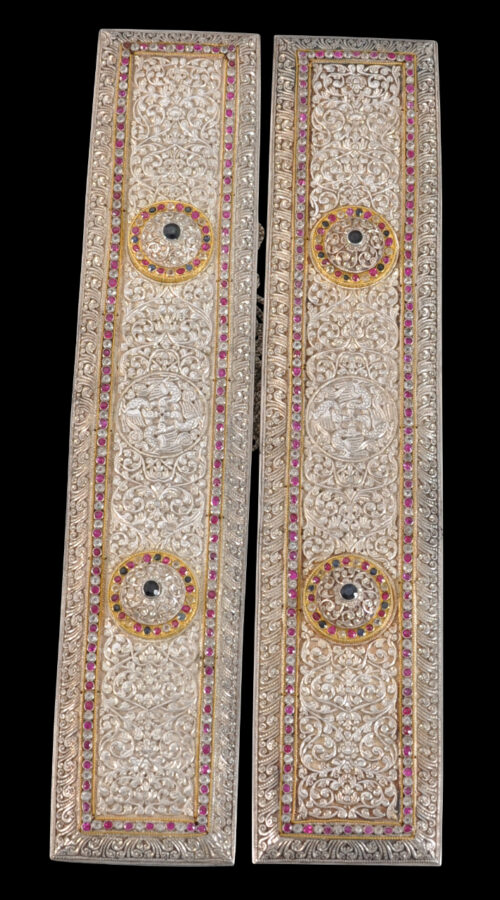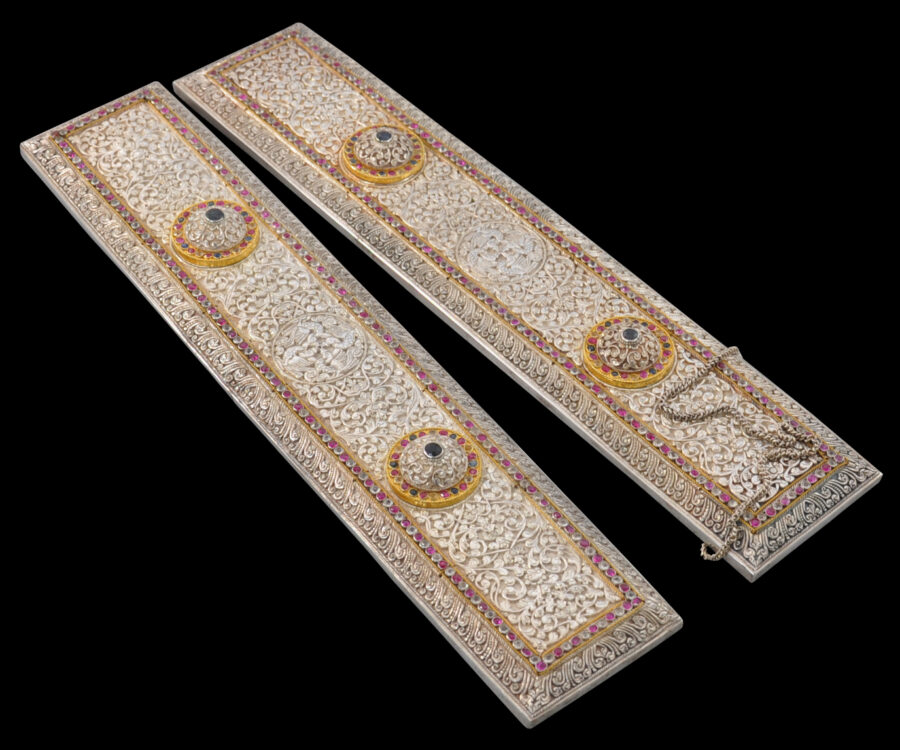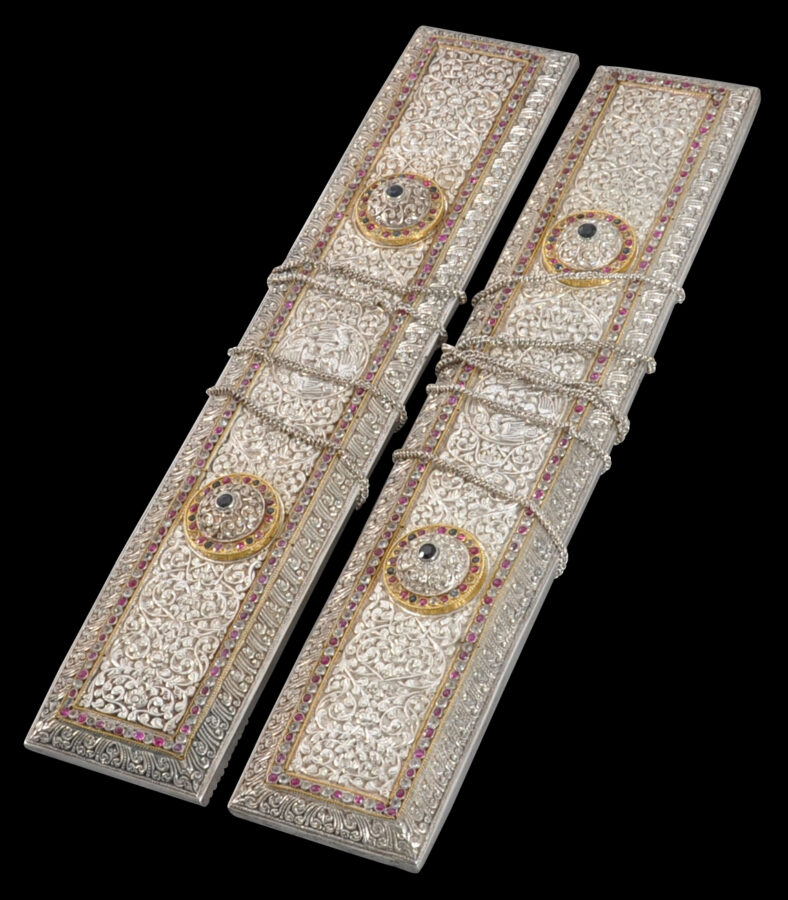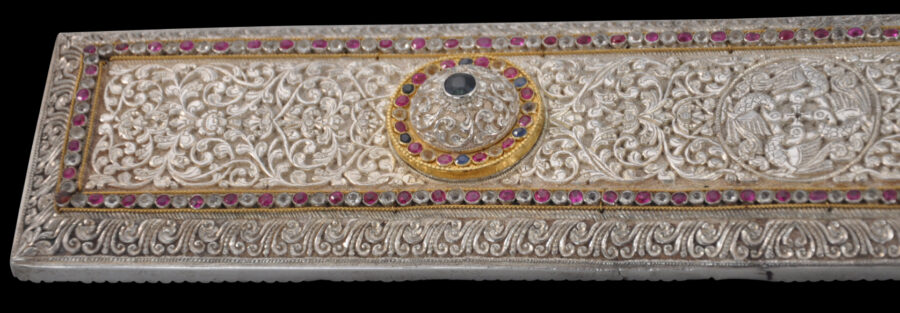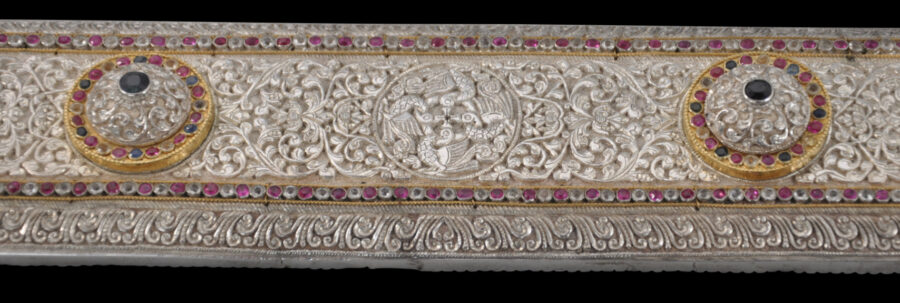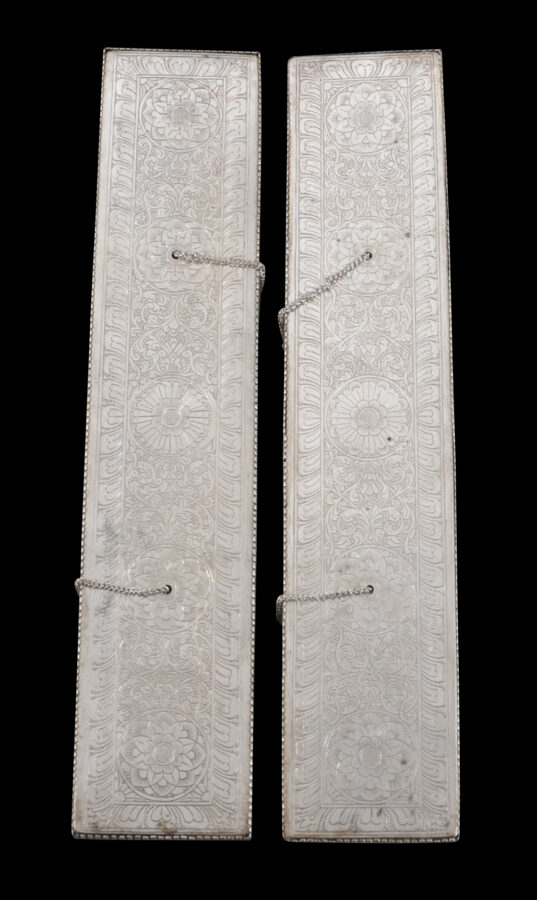Most Sri Lankan manuscript covers are of wood. (The manuscripts or ola themselves were of palm leaf.) Finer examples are painted. Sometimes more important examples are sheaved in silver. Very rare examples are covered in silver, gold and gems.
This splendid and rare pair of Sri Lankan manuscript covers are of wood substrate that is completely covered in chased and engraved (almost pure) silver panelling that has been inset with faceted pink and blue sapphires, rock crystal and other gems. Each also retains its pairs of domed binding-cord buttons and these are covered in thick gold and silver sheet and set with faceted gems. The binding cords in the examples here are not cotton string as is usually the case but delicate chains made of high-grade silver. These are threaded through small holes in the covers.
The covers are rectangular, with bevelled edges. The central part of each cover has a roundel filled with four sacred swan motifs (hamsas) arranged in a spiral formation known as hamsa puttuva surrounded by dense scrolling katiri mala flower and vine motifs in a chain or havadiya pattern, all in high relief. The edges have a petal-like pala peti border.
The undersides of the covers are covered in sheet silver that is finely engraved with a series of lotus medallions surrounded by vegetal trellis work within pala peti borders.
Elaborate examples with silver, gold ivory and studded with gems are illustrated in Tammita-Delgoda (2006). These are from the Tibbotuwave Temple, Malwatte Vihare, in Kandy.
Undoubtedly, the use of expensive and luxuriantly repoussed silver and gold covers is meant to convey the important of the enclosed manuscript, and also the importance of the individual who probably commissioned the covers for donation to a monastery or temple as an act of merit.
The work on these covers is typical of that done in and around Kandy, the location of Sri Lanka’s famous Tooth Temple and the former seat of power of the Kandyan kings.
The two covers are in excellent condition. The silver and gold work is exceptionally fine in quality and ranks among the finest examples of Kandyan silverwork. The covers are rare and museum-worthy.
About Sri Lankan Palm Leaf Manuscripts
Most Sri Lankan palm leaf manuscripts are written on the prepared leaves of the Talipot palm (Corypha umbraculifera). It is one of the largest palms to grow in Sri Lanka and grows to a height of 15-35 metres. The trees take 40 to 100 years to reach maturity and before the tree dies, it shoots out from its top an inflorescence that can be as long as 7 metres.
The material used for preparing the writing leaf is taken from young trees and from the unopened leaf buds of such trees. Each leaf bud grows to 3 to 7 metres long and can hold up to 100 leaflets.
The preparation of the writing leaf required much care. A young tree would be selected and when the leaf bud was about to burst open it was cut off and slit open. The leaflets were then separated and removed one by one. The midribs of the leaflets were removed and the leaflets were them immersed in a vessel filled with cold water.
The vessel was then placed over a slow fire until the water reached boiling point. Thereafter the heat was reduced and the leaflets were allowed to simmer for several hours. The leaflets then were taken out and allowed to dry for three days in the sun. Thereafter the leaflets were exposed to the cooler night air for three nights, allowing them to become supple.
The next stage of the preparation process involved each leaf blade being weighted and then pulled up and down over the smooth surface of a cylinder of wood which was usually the smoothed trunk of an areca palm (the tall, thin palm that produces betel nut.)
The manuscript pages then were cut from the leaves. They were punched with one or two holes using a steel punch. The holes later were used in the filing of the pages – a bamboo slither was passed through a hole in each page so that all the pages could be held together. Held together, the edges of the pages were then singed with a hot iron and burnt to remove any irregularities so that each page would be of uniform length and width.
Writing on each page was done with a stylus that had a steel point which was sharpened from time to time on an oiled stone. The writing then had to be blackened otherwise it was too faint. This was done with ink made from combining fine dust made from charcoal from leaves, commonly cotton plant leaves, with an alluvial resin. The mixture was heated until a black resinous oil was produced. This was rubbed over the manuscript pages with a cloth so that the whole page was covered with black. This was then rubbed away with sifted rice bran, leaving the black resin in the scratched depressions left on the page by the style. Palm leaf books were not normally illustrated.
Once the pages were finished, two covers were produced for them. These were made to size. The edges almost always were bevelled and the inner and outer surfaces usually were painted, usually with colourful designs. The covers were made from one of various types of local woods such as ebony, iron wood, val sapu, gammalu, jak or milla.
The leaves of the book and the covers then were strung together with a cord, either a cotton cord or one made from the fibre of the niyanda leaf. Most covers were made of wood. More important manuscripts also had outer covers of silver or ivory.

High priests reading from palm leaf books, circa 1900.

An eighteenth century cave wall painting at Degaldoruwa Temple, central Sri Lanka, which shows a Kandyan king reading from an ola manuscript.
References
Coomaraswamy, A.K., Mediaeval Sinhalese Art, Pantheon Books, 1956 reprint of the 1908 edition.
Pal, P., Art from Sri Lanka & Southeast Asia: Asian Art at the Norton Simon Museum, Yale University Press, 2004.
De Silva, W.A, Catalogue of Palm Leaf Manuscripts in the Library of the Colombo Museum, Volume 1, 1938.
Tammita-Delgoda, S., Ridi Vihare: The Flowering of Kandayan Art, Stamford-Lake, 2006.


